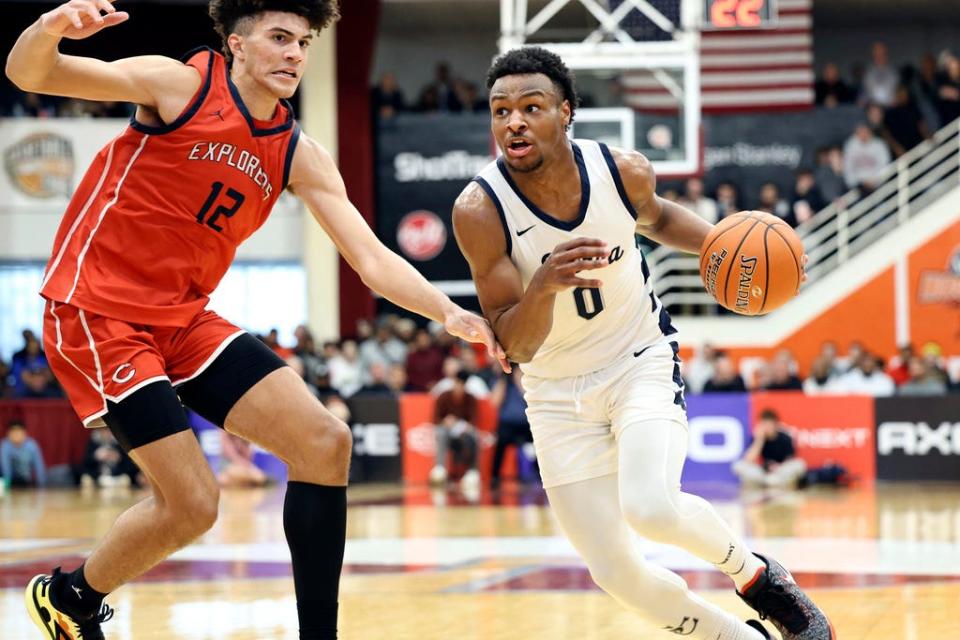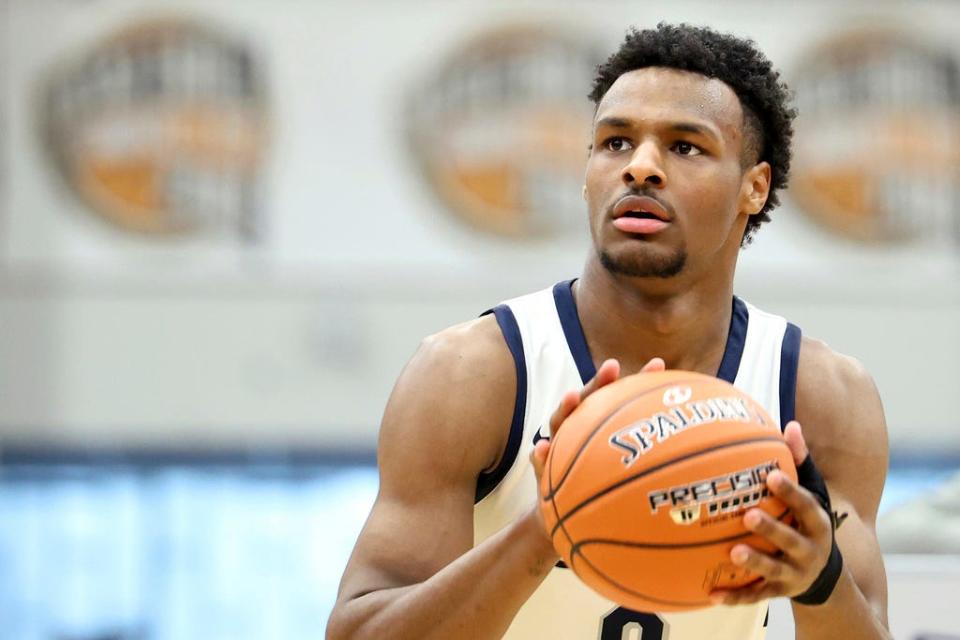How common is cardiac arrest in young athletes like Bronny James? We asked Akron experts

With news that Bronny James, LeBron James’ oldest son, went into cardiac arrest during a workout Monday, the Beacon Journal asked two local experts more about cardiac arrest in young athletes.
According to a report from TMZ Sports, James, who committed to play basketball for the University of Southern California this past winter, suffered a cardiac arrest during a workout at USC.
James had the incident at USC’s Galen Center and was taken by ambulance to a hospital.
Dr. Joseph Congeni, medical director of Akron Children's Hospital's Sports Medicine department, and Dr. John Clark, a pediatric cardiologist and director of Akron Children’s Pediatric Arrhythmia Center, answered some questions about cardiac arrest by phone Tuesday.

What is cardiac arrest? What is the difference between cardiac arrest and a heart attack?
Cardiac arrest occurs when the heart abruptly loses its normal rhythm and stops pumping blood. A heart attack can cause cardiac arrest, but not all cardiac arrests are caused by heart attacks. A heart attack happens when a blood clot stops blood flow to the heart.
How common is cardiac arrest in young athletes?
Cardiac arrest is extremely rare and occurs in 1 out of 100,000 athletes, said Clark.
But “it still happens enough that we worry about it,” said Congeni.
There are 25 to 75 cases a year and that’s only of the reported cases in high schools, college and professional sports, so there could be more, he said.
What can cause a young, high-level athlete to go into cardiac arrest?

The No. 1 cause of a cardiac arrest is a congenital heart abnormality, or a defect that's present at birth, said Congeni. Under strenuous exercise, those abnormalities of the heart could cause the heart to stop beating.
About 50% of all cardiac arrests in young patients are caused by hypertrophic cardiomyopathy, which is inherited from parents, said Clark. This condition affects the main pumping chamber of the heart.
Are there screenings for risk of cardiac arrest?
The best way to screen for heart issues is with an expensive echocardiogram. But with more than 35 million youth athletes in the country, the decision in medical circles has been not to do an echocardiogram on every single athlete, Congeni said.
Even with screening, that doesn’t preclude a cardiac arrest from happening, Clark said.
Fifty percent of what causes a cardiac arrest aren’t found in an echocardiogram screening, he said.
Elite athletes also have thicker hearts, and then the question becomes: Do they have a thicker heart because they are an elite athlete or is it hypertrophic cardiomyopathy? The only way to find out is to suspend all exercise for six months and repeat the echo, he said.
Still, physicals with physicians are important for all athletes, the doctors said. While upward of 90% of heart murmurs are normal and do not turn into any issues, a detected murmur could be discussion for a physician to further investigate a patient’s health, Congeni said.
Does an athlete feel any symptoms before a cardiac arrest?
A person who suffers cardiac arrest usually just collapses, said Clark. The difference between someone passing out and having a cardiac arrest is the lack of a pulse.
“When they go down with a cardiac arrest, once they hit the floor, they're not moving. There is no pulse. There's no breathing. There's no movement,” said Clark. “Check those things and start CPR while someone's running to get the AED machine.”
Cardiac arrest patients rarely report feeling lightheaded or any symptoms before the arrest, he said.
"If you watch any of the videos, they're running along and two steps later, they're on the ground. They don't remember anything. They didn't feel anything,” Clark said. “Often they get hurt. They lose teeth. They get stitches. They break bones when they hit because they hit so hard.”

What should you do when someone is in cardiac arrest?
AED machines, or automated external defibrillators, are life-saving machines and should immediately be grabbed when someone experiences cardiac arrest, both doctors said.
Report: Bronny James suffers cardiac arrest at workout on USC campus
Congeni, whose department works with many area high school sports trainers, said the good news is that schools often have multiple AED machines on the sidelines and within the schools.
Time is of the essence, and anybody — even an untrained bystander — can save a life with the AED machine, said Clark.
The machines are also not just for athletes, but any spectator who might have a cardiac arrest, he said.
“They're bulletproof devices,” he said. “There are two buttons: 'on' and 'shock,' and it gives you verbal commands. If they need a shock, it will tell you to push the shock button. And if it's noisy and you can't hear what it's saying, it’s printing it in large print across the screen.
“If the patient doesn't need a shock, it will not deliver it no matter how many times you push the button,” Clark said. “Whether you’ve ever seen (an AED machine) or not, if it’s there, use it.”
Getting the shock to the heart with the AED machine quickly saves lives, Clark said.
According to one study, adults who didn't receive CPR or aid from an AED after going into cardiac arrest had a 5% chance of survival, Clark said. If CPR is performed and an AED is used within three minutes, that survival rate went up to 73%.
Clark said in his 25 years at the hospital, “I've never had an athlete who had an AED used within three minutes who had a bad outcome.”
Can athletes continue to compete after experiencing cardiac arrest?
When — and if — an athlete can return to competition after cardiac arrest depends on the cause.
“The current guidelines say, if you have a diagnosed condition, if you're arrhythmia-free and compliant with care recommendations, you can go back to sports in six months,” said Clark. “But you know, how that's going to apply to Bronny is a big question.
"Step one is they have to figure out what caused it,” Clark said.
Is there any link to the COVID-19 vaccine or COVID and cardiac arrest in athletes?
Some COVID-19 vaccine skeptics, including Elon Musk on Twitter, have questioned whether Bronny’s cardiac arrest is from the COVID-19 vaccine or COVID-19. It is unknown whether Bronny was vaccinated or has had COVID-19, though LeBron James in 2021 said he was vaccinated against the virus.
The likelihood that cardiac arrest is a result of the COVID vaccine or COVID-19 is "highly, highly unlikely,” said Clark.
The risk of myocarditis, or an inflammation of the heart, from the COVID-19 vaccine is about 1 in 20,000, and those tend to be fairly minor symptoms and minimal findings, said Clark. The risk of cardiac arrest after a COVID-19 vaccine is “far less than that and sort of equivalent to the overall risk of cardiac arrest in any young athlete, which is about 1 out of 100,000 athletes,” he said.
There is also a very low risk of cardiac arrest as a result of COVID-19, Clark said.
Myocarditis may result in other issues for an athlete, and cardiac arrest is low on that list, he said.
Additionally, Clark said, he would ask how long ago the vaccine or COVID-19 infection was and “if it wasn't in the last couple of months, it's almost impossible to be related.”
Reaction: Damar Hamlin sends Bronny James well wishes as Elon Musk erroneously blames vaccines
What advice do you have for parents of young athletes?
“The best advice I can give them is make sure whatever team that your child plays on that they have an AED and that you learn CPR and you know how to use it,” said Clark.
“We can turn your child inside out looking for bad things, but in doing that, the best we can hope for is that we've just taken your child's risk from 1 in 100,000 — it's really rare — to 1 in 200,000 because if we do a full screen on everyone, we’ve dropped the risk,” he said. “It's far more likely that they’re going to have some catastrophe when you give them the car keys so that you need to worry about more than them playing sports.”
Beacon Journal medical reporter Betty Lin-Fisher can be reached at 330-996-3724 or blinfisher@thebeaconjournal.com. Follow her @blinfisherABJ on Twitter or www.facebook.com/BettyLinFisherABJ. To see her most recent stories and columns, go to www.tinyurl.com/bettylinfisher
This article originally appeared on Akron Beacon Journal: How common is cardiac arrest in young athletes like Bronny James?

